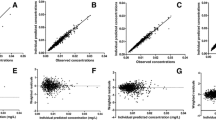Abstract
Basiliximab is an immunosuppressant chimeric monoclonal antibody directed to the human interleukin-2 receptor α-chain used for prevention of acute rejection episodes in organ transplantation. The minimally effective serum concentration necessary to saturate receptor epitopes in kidney transplant patients is 0.2 μg/ml. To guide dose selection for Phase 3 efficacy trials, a population pharmacostatistical model was fitted to intensively sampled Phase 2 pharmacokinetic data. This served as a basis from which to examine candidate dose regimens with respect to the duration over which receptor-saturating concentrations would be achieved posttransplant. Three prediction methods were assessed: one based on simulations, and two others based on first-order approximation using either inverse regression or inversion of confidence intervals. An 80% prediction interval was generated by each method to evaluate its predictive performance against prospectively collected Phase 3 data in 39 renal transplant patients who received two injections of 20mg basiliximab, one prior to surgery and one on Day 4 posttransplant. All methods provided correct prediction of the duration of receptor-saturating concentration. As anticipated, the best performance was obtained from the simulation method which predicted 30 values in the 80% prediction interval, 19.7–52.7 days. The actually observed 80% interval from the Phase 3 data was 23.7–58.3 days.
Similar content being viewed by others
REFERENCES
P. L. Amlot, E. Rawlings, O. N. Fernand, P. J. Griffin, G. Heinrich, M. H. Schreier, J. P. Castaigne, R. Moore, and P. Sweny. Prolonged action of a chimeric interleukin-2 receptor (CD25) monoclonal antibody used in cadaveric renal transplantation. Transplantation 60:748-756 (1995).
J. M. Kovarik, P. Wolf, D. Durand, G. Mourad, Y. Lebranchu, P. Lang, B. Bourbigot, D. Cantarovich, D. Girault, C. Gerbeau, A. G. Schmidt, and J. P. Soulillou. Disposition of basiliximab, an interleukin-2 receptor monoclonal antibody, in recipients of mismatched cadaver renal allografts. Transplantation 64:1701-1705 (1997).
G. P. Basadonna, A. J. Matas, K. J. Gillingham, et al. Early versus late acute renal allograft rejection: impact on chronic rejection. Transplantation 55:993-995 (1993).
M. Davidian and D. M. Giltinan. Nonlinear Models for Repeated Measurement Data, Chapman & Hall, London, 1995.
C. Osborne. Statistical calibration: A review. Int. Statist. Rev. 59:309-336 (1991).
M. A. Gruet and E. Jolivet. Calibration with a nonlinear standard curve: How to do it? Comput. Stat. 9:249-276 (1994).
Q. Zeng and M. Davidian. Bootstrap-adjusted calibration confidence intervals for immunoassay. J. Am. Statist. Assoc. 92:278-290 (1997).
S. L. Beal, A. J. Boeckmann, and L. B. Sheiner. NONMEM User's Guide, University of California at San Francisco, San Francisco, 1992.
J. R. Schwenke and G. A. Milliken. On the calibration problem extended to nonlinear models. Biometrics 47:563-574 (1991).
J. D. Unadkat, S. L. Beal, and L. B. Sheiner. Bayesian calibration. Anal. Chim. Acta 181:27-36 (1986).
D. M. Giltinan and M. Davidian. Assays for recombinant proteins: A problem in nonlinear calibration. Statist. Med. 13:1165-1179 (1994).
J. L. Steimer, A. Mallet, J. L. Golmard, and J. F. Boisvieux. Alternative approaches to estimation of population pharmacokinetic parameters with the nonlinear mixed effect model. Drug Metab. Rev. 15:265-292 (1984).
D. J. Roe. Comparison of population pharmacokinetic modeling methods using simulated data: Results from the population modeling workgroup. Statist. Med. 16:1241-1262 (1997).
B. P. Carlin and A. E. Gelfand. Approaches for empirical Bayes confidence interval. J. Am. Statist. Assoc. 85:105-114 (1990).
J. F. Robinson-Cox. Multiple estimation of concentrations in immunoassay using logistic models. J. Immunol. Meth. 186:79-88 (1995).
B. Nashan, R. Moore, P. Amlot, A. G. Schmidt, K. Abeywickrama, and J. P. Soulillou. Randomised trial of basiliximab versus placebo for control of acute cellular rejection in renal allograft recipients. Lancet 350:1193-1198 (1997).
S-Plus User's Manual, Statistical Sciences, Seattle, WA, 1991.
B. A. Belanger, M. Davidian, and D. M. Giltinan. The effect of variance function estimation on nonlinear calibration inference in immunoassay data. Biometrics 52:192-210 (1996).
J. Wakefield. An expected loss approach to the design of dosage regimens via sampling-based methods. Statistician 43:13-29 (1994).
E. F. Vonesh and V. M. Chinchilli. Linear and Nonlinear Models for the Analysis of Repeated Measurements, Marcel Dekker, New York, 1997, pp. 359-364.
E. F. Vonesh. A note on the use of Laplace's approximation for nonlinear mixed-effects models. Biometrika 83:447-452 (1996).
Author information
Authors and Affiliations
Rights and permissions
About this article
Cite this article
Mentré, F., Kovarik, J. & Gerbeau, C. Constructing a Prediction Interval for Time to Reach a Threshold Concentration Based on a Population Pharmacokinetic Analysis: An Application to Basiliximab in Renal Transplantation. J Pharmacokinet Pharmacodyn 27, 213–230 (1999). https://doi.org/10.1023/A:1020658023774
Published:
Issue Date:
DOI: https://doi.org/10.1023/A:1020658023774




